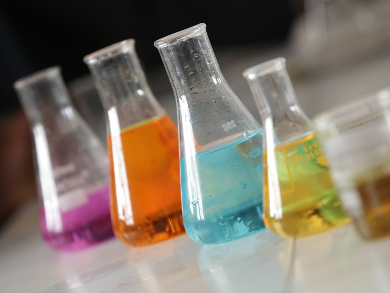The main factors driving research in chemistry and other areas in science include the search for cheaper, more efficient, more accurate, greener, and smaller alternatives. How do these factors relate to analytical chemistry? The Analytica Trade Fair in Munich earlier this year with nearly 36.000 visitors inspired me to take a closer look.
Decreasing Scale
Miniaturization is perhaps the most notable current trend in analytical chemistry. Rapid developments in instrumentation have led to an impressive range of benchtop technology and portable devices. Who would have thought some decades ago that an NMR spectrometer can have the size of a shoebox and fit conveniently on your lab bench?
The smaller size also allows the equipment to become portable, which is revolutionizing analytical measurements in many areas. Nowadays a Raman spectrometer can fit in your pocket for a quick identification of explosives and other illicit substances in the field. The more affordable prices and easily operated devices are key factors along with the equipment’s shrinking size for their increasing popularity. Food and beverage industries can with ease test their products in the field and water can be tested on-site, to name some examples. MEMS technology has an increasingly growing role in analytical applications and even smartphones are used for monitoring.
The range of portable analytical instruments includes spectroscopic analysis, elemental analysis, thermal analysis and electrochemical analysis. The measurement of pH constitutes the widest use of portable devices. Portable spectroscopic analysis is expected to experience the highest growth in a wide range of applications requiring high precision, including drug testing, environmental testing and the analysis of food and beverages [1].
 |
|
The trend towards more sustainable methods can also be observed in analytical chemistry. |
Going Greener
An emerging branch of analytical chemistry focuses on the sustainable aspects of the field and is appropriately called green analytical chemistry. The focus is on the minimized consumption of hazardous substances and maximized safety for operators and the environment.
The recycling, replacement, reduction, and detoxification of reagents and solvents are some key strategies for developing greener analytical methods. Remote sensing and the direct measurement of untreated samples, on-line treatment of waste as well as automation are some approaches to be used in the analysis. Miniaturization of procedures and instrumentation is also a key strategy in green analytical chemistry.
Better Results Faster
Important results of the improvements in analytical technology are high-throughput methods for more efficient analysis. Ultra-Performance Liquid Chromatography (UPLC) beats traditional High-Performance Liquid Chromatography (HPLC) due to its higher throughput and enhanced ability for separation. Especially in the pharmaceutical industry, UPLC is widely used.
The improved technology has also led to the generation of more data. The developments have occurred hand in hand with progress in software and computers. The vast amounts of data are a challenge as well as an opportunity. Large amounts of data need to be sorted, stored and reliably analyzed. This highlights the need for a skilled analytical chemist to be a statistician or chemometrician as well as a specialist in sampling, instrumentation, and interpretation.
Although analytical chemistry is traditionally a very hands-on type of field, a stronger involvement of computers and the more frequent use of simulations can be observed. Specific programs for method development, such as DryLab, allow researchers to predict chromatograms with very few data points, thus saving the time and costs required by additional experiments [2].
The rise of continuous techniques can be observed, for example in the area of separation techniques through the development of continuous separations. There is a clear trend for replacing multistep, batch-type techniques.
Hyphenated techniques have become established as standard tools in the last decades. Methods such as GC x GC-MS and LC x LC-MS are widely used and developments are taking place not only in column technology, but especially in the area of mass spectrometry. Triple quadrupole mass spectrometers (QqQ MS) can provide highly selective and sensitive in comparison with single quadrupole mass spectrometry. Tandem mass spectrometry (MS/MS) is also an emerging area.
Future Developments
Analytical chemistry is currently an exciting field and one to keep an eye on. It can be seen as an enabling discipline in helping the development of many other fields where the tools of analytical chemistry are used. The coming years will tell how this toolbox develops and what new functions will soon be possible.
 |
|
Many related disciplines benefit from the advances in analytical chemistry. |
References
- [1] Report: Portable Analytical Instruments Market: Global Forecast until 2020, 2016.
- [2] DryLab, Software for HPLC Method Development, Molnár-Institute, Berlin, Germany (http://molnar-institute.com/drylab/ accessed July 2017)
Also of Interest
- Event: Analytica Trade Fair 2020
Munich, Germany, March 31 to April 3, 2020




